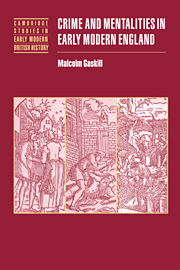1 - Mentalities from crime
from Introduction
Published online by Cambridge University Press: 05 July 2012
Summary
The value of criminal records for history is not so much what they uncover about a particular crime as what they reveal about otherwise invisible or opaque realms of human experience.
Muir and Ruggiero, 'Introduction: the crime of history', p. vii.This is a book about the changing mental world of English people between the mid-sixteenth and mid-eighteenth centuries, and how that world might be reconstructed and understood through the history of crime and criminal justice. As such, it is concerned with crime only in so far as crime allows insights into mentalities, rather than with crime per se. Indeed, attention is limited to three specific crimes - witchcraft, coining and murder - the aim being to explore what public and private reactions to these peculiarly significant offences reveal about how our ancestors - mostly ordinary working people - perceived themselves, their social environment and their universe, and, conversely, how these perceptions both reflected and shaped popular beliefs and behaviour over time.
Although, like all excursions into the history of mentalities, these case studies will attract criticism of both purpose and method, it is a central contention that the most one can do is explain what is to be described and how, all the while keeping a careful eye on reasonable limits of interpretation. This introductory chapter, therefore, draws upon a range of historical and anthropological works to define mentalities in general, and indicate what they mean here in particular. From there, four themes of long-term continuity and change are outlined, then linked to the concrete human contexts from which they derive substance and meaning.
- Type
- Chapter
- Information
- Crime and Mentalities in Early Modern England , pp. 3 - 30Publisher: Cambridge University PressPrint publication year: 2000



